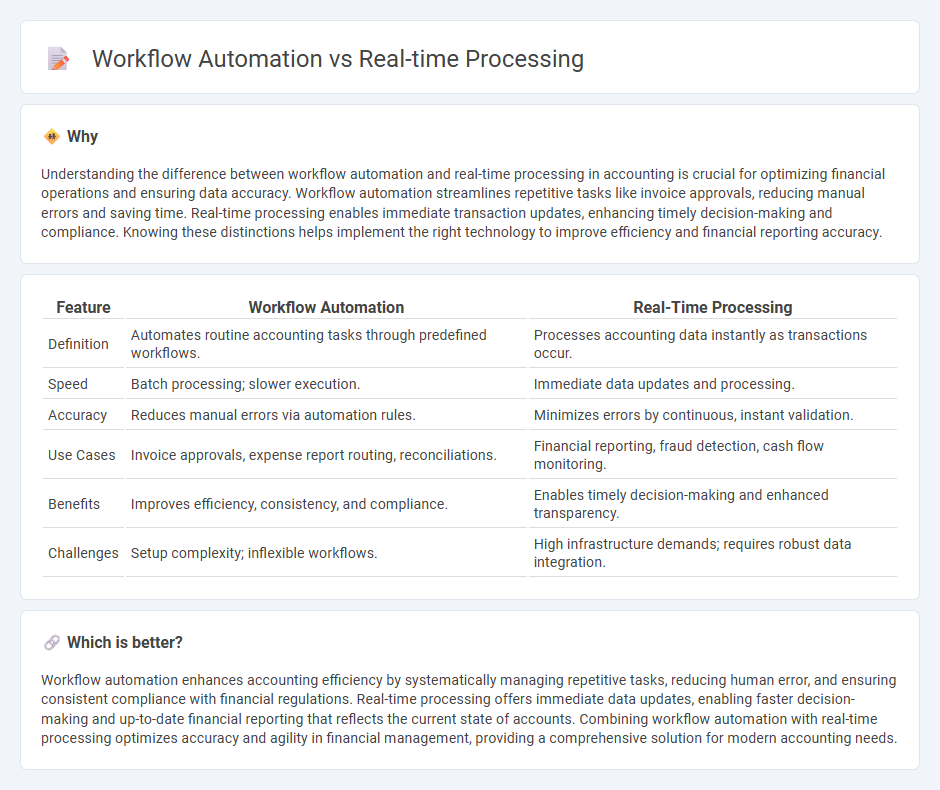
Workflow automation in accounting streamlines repetitive tasks such as invoicing, reconciliation, and data entry, enhancing efficiency and reducing human error. Real-time processing enables instant recording and updating of financial transactions, providing immediate visibility into cash flow and financial status. Explore how integrating these technologies can revolutionize your accounting practices.
Why it is important
Understanding the difference between workflow automation and real-time processing in accounting is crucial for optimizing financial operations and ensuring data accuracy. Workflow automation streamlines repetitive tasks like invoice approvals, reducing manual errors and saving time. Real-time processing enables immediate transaction updates, enhancing timely decision-making and compliance. Knowing these distinctions helps implement the right technology to improve efficiency and financial reporting accuracy.
Comparison Table
| Feature | Workflow Automation | Real-Time Processing |
|---|---|---|
| Definition | Automates routine accounting tasks through predefined workflows. | Processes accounting data instantly as transactions occur. |
| Speed | Batch processing; slower execution. | Immediate data updates and processing. |
| Accuracy | Reduces manual errors via automation rules. | Minimizes errors by continuous, instant validation. |
| Use Cases | Invoice approvals, expense report routing, reconciliations. | Financial reporting, fraud detection, cash flow monitoring. |
| Benefits | Improves efficiency, consistency, and compliance. | Enables timely decision-making and enhanced transparency. |
| Challenges | Setup complexity; inflexible workflows. | High infrastructure demands; requires robust data integration. |
Which is better?
Workflow automation enhances accounting efficiency by systematically managing repetitive tasks, reducing human error, and ensuring consistent compliance with financial regulations. Real-time processing offers immediate data updates, enabling faster decision-making and up-to-date financial reporting that reflects the current state of accounts. Combining workflow automation with real-time processing optimizes accuracy and agility in financial management, providing a comprehensive solution for modern accounting needs.
Connection
Workflow automation streamlines accounting processes by reducing manual tasks, enabling real-time processing of financial data. Real-time processing ensures immediate updates and accurate financial reporting, enhancing decision-making efficiency. Together, they improve accuracy, speed, and compliance within accounting systems.
Key Terms
Transaction Processing
Real-time processing in transaction systems ensures immediate data handling, minimizing latency and enabling instant decision-making critical for financial operations. Workflow automation streamlines transaction processes by integrating sequential tasks and reducing manual intervention, enhancing overall efficiency and accuracy. Explore the nuances of transaction processing through real-time and workflow automation to optimize your business operations effectively.
Business Process Management (BPM)
Real-time processing enables instantaneous data analysis and decision-making within Business Process Management (BPM), enhancing operational efficiency and responsiveness. Workflow automation streamlines repetitive tasks by creating predefined sequences, reducing errors and increasing consistency in BPM systems. Explore how integrating real-time processing with workflow automation can transform your BPM strategy for optimal performance.
Audit Trail
Real-time processing ensures immediate capture and logging of transactions, creating an accurate and up-to-date audit trail critical for compliance and forensic analysis. Workflow automation enhances audit trails by systematically recording each step and decision point within processes, enabling traceability and accountability. Explore how integrating both approaches can strengthen your organization's audit integrity and operational transparency.
Source and External Links
What Is Real-Time Processing (In-depth Guide For Beginners) - Real-time processing collects, processes, analyzes, and distributes data as it is generated to enable immediate decision-making and business insights.
What is Real-Time Processing? - Dremio - Real-time processing handles data as it arrives with minimal delay, producing instant output for tasks requiring immediate responses such as fraud detection and quality control.
Real-Time Data Processing: 2024 Trends & Use Cases - Portable.io - Real-time data processing ingests and processes data streams immediately after generation, using scalable pipelines and stream processors for timely analytics and operational actions.
 dowidth.com
dowidth.com